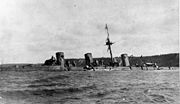.gif)
Japanese cruiser Suzuya (1904)
Encyclopedia
The was a protected cruiser
Protected cruiser
The protected cruiser is a type of naval cruiser of the late 19th century, so known because its armoured deck offered protection for vital machine spaces from shrapnel caused by exploding shells above...
in the Imperial Japanese Navy
Imperial Japanese Navy
The Imperial Japanese Navy was the navy of the Empire of Japan from 1869 until 1947, when it was dissolved following Japan's constitutional renunciation of the use of force as a means of settling international disputes...
, acquired as a prize of war
Prize of war
A prize of war is a piece of military property seized by the victorious party after a war or battle, typically at sea. This term was used nearly exclusively in terms of a captured ship during the 18th and 19th centuries....
during the Russo-Japanese War
Russo-Japanese War
The Russo-Japanese War was "the first great war of the 20th century." It grew out of rival imperial ambitions of the Russian Empire and Japanese Empire over Manchuria and Korea...
from the Imperial Russian Navy
Imperial Russian Navy
The Imperial Russian Navy refers to the Tsarist fleets prior to the February Revolution.-First Romanovs:Under Tsar Mikhail Feodorovich, construction of the first three-masted ship, actually built within Russia, was completed in 1636. It was built in Balakhna by Danish shipbuilders from Holstein...
, where it was originally known as the .
Background
The Novik was originally built for the Imperial Russian NavyImperial Russian Navy
The Imperial Russian Navy refers to the Tsarist fleets prior to the February Revolution.-First Romanovs:Under Tsar Mikhail Feodorovich, construction of the first three-masted ship, actually built within Russia, was completed in 1636. It was built in Balakhna by Danish shipbuilders from Holstein...
as the Novik, by Schichau
Schichau
Schichau Elbing or Schichau may refer to:The German surname* Ferdinand Schichau , the German businessman and engineer who founded the Schichau-Werke...
shipyards in Elbing
Elbing
Elbing is the German name of Elbląg, a city in northern Poland which until 1945 was a German city in the province of East Prussia.Elbing may also refer to:- Ships :* SMS Elbing, light cruiser of the Imperial Germany Navy...
near Danzig, Germany
Germany
Germany , officially the Federal Republic of Germany , is a federal parliamentary republic in Europe. The country consists of 16 states while the capital and largest city is Berlin. Germany covers an area of 357,021 km2 and has a largely temperate seasonal climate...
. It performed heroically in various engagements in the Russo-Japanese War
Russo-Japanese War
The Russo-Japanese War was "the first great war of the 20th century." It grew out of rival imperial ambitions of the Russian Empire and Japanese Empire over Manchuria and Korea...
of 1904-1905, and was captured by the Japanese Navy after being scuttled at Sakhalin
Sakhalin
Sakhalin or Saghalien, is a large island in the North Pacific, lying between 45°50' and 54°24' N.It is part of Russia, and is Russia's largest island, and is administered as part of Sakhalin Oblast...
after the Battle of the Yellow Sea
Battle of the Yellow Sea
The Battle of the Yellow Sea was a major naval engagement of the Russo-Japanese War, fought on 10 August 1904. In the Russian Navy, it was referred to as the Battle of 10 August. The battle foiled an attempt by the Russian fleet at Port Arthur to break out and form up with counterparts from...
.
Service life
The Japanese navy had been impressed with the speed of the Novik, and despite the considerably damage inflicted upon the vessel by its combat with the and (and the damage created by its own crew it scuttling the vessel), the wreck of the Novik was salvaged and repaired at the Yokosuka Naval ArsenalYokosuka Naval Arsenal
was one of four principal naval shipyards owned and operated by the Imperial Japanese Navy, and was located at Yokosuka city, Kanagawa prefecture on Tokyo Bay, south of Yokohama...
, and commissioned it into the Imperial Japanese Navy as the Suzuya on 20 August 1906. Its new name came from the Suzuya River in Karafuto, near where the Novik was captured.
With its light armaments and armor, the Suzuya was re-classified by the IJN as a tsūhōkan, meaning dispatch boat or aviso
Aviso
An aviso , a kind of dispatch boat or advice boat, survives particularly in the French navy, they are considered equivalent to the modern sloop....
. Indeed she served with the IJN primarily for high speed reconnaissance and as a dispatch vessel; however, due to its battle damage and fewer boilers, the repaired vessel could only attain a maximum speed of 19 knots (37 km/h), as opposed to 25 knots (49 km/h) in its original configuration. Furthermore, the development of wireless communications quickly made such dispatch vessels obsolete. The Suzuya was re-classified as a 2nd class Coastal Defense Vessel
Coastal defence ship
Coastal defence ships were warships built for the purpose of coastal defence, mostly during the period from 1860 to 1920. They were small, often cruiser-sized warships that sacrificed speed and range for armour and armament...
on 28 August 1912, and was declared obsolete and scrapped on 1 April 1913.


